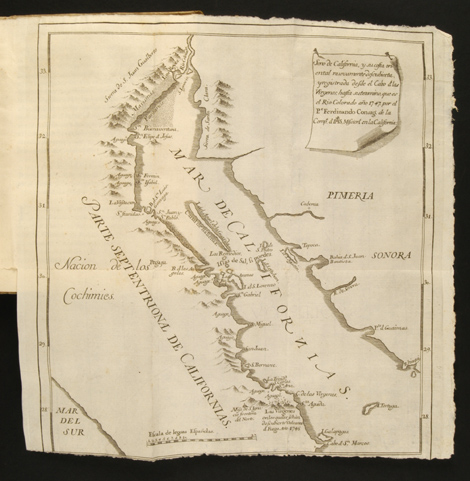Croatian Science, 20th-21st centuries
Croatian Medicine
History of Croatian Science, 15th-19th centuries
© by Darko Zubrinic, Zagreb (1995)
In this section we should again mention the names of Mark Antun Dominis and Rugjer Boskovic (1711-1787), whose work was veritably encyclopaedistic.
The first known manual about book-keeping was Della mercatura e del mercante perfetto, (On merchantry and the perfect merchant) written in 1458 by Benko Kotruljic or Benedikt Kotruljevic (Benedictus de Cotrullis, born in Dubrovnik, 1416-1469). It is also the oldest known manuscript on double-entry. As such it precedes Luca Pacioli's description of double-entry for no less than 36 years, so that Kotruljic's priority is indisputable.

Kotruljic's
famous 1464
manuscript on
book-keeping,
was printed in 1573 in Venice; editor and publisher was
another oustanding Croatian scholar - Franjo Petris
The French translation of Kotruljic's book appeared under the title "Parfait négociant" in Lyon in 1613.
In the book he states the following: "I declare that a merchant must not only be a good writer,accountant and book-keeper, but he also has to be a man of letters and rhetorician."
His another important manuscript is Benedictus de Cotrullis: "De Navigatione", 1464, written also in Italian. It is the first known manual on navigation in the history of Europe. Note that it appeared almost 30 years before the discovery of America. The book has been frequently copied throughout Mediteranean.

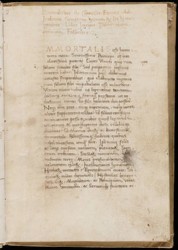
Benedictus
de Cotrullis: De
Navigatione,
1464;
photo from Beinecke Rare Book &
Manuscript Library
The original manuscript is kept at the University of Yale (in the Beinecke Rare Book and Manuscript Library, MS 557), and has 132 pp. See
- Darko Novakovic (discoverer of the book): Novopronadeni rukopis Benedikta Kotruljevica De navigatione, in Dubrovcanin Benedikt Kotruljevic : hrvatski i svjetski ekonomist XV. stoljeca. - Zagreb, Hrvatska akademija znanosti i umjetnosti : Hrvatski racunovoda, 1996. - ISBN 953-96998-0-0. - pp. 19-32.
- Benedikt Kotruljevic: De navigatione / O plovidbi, Zagreb 2005., ISBN 953-6310-37-6 (parallel Italian-Croatian edition)
- Dubrovcanin Benedikt Kotruljevic, Hrvatski i svjetski ekonomist XV. stoljeca, HAZU, Zagreb 1996. (radovi s konferencije)
- Beinecke Rare Book & Manuscript Library, Yale University (write in MS 557 and search; 20 pages of the book can be seen)
- Benedetto Cotrugli: De Navigatione, online book
In this book Kotruljevic mentions places like Bocari (Bakar), Braca (Brac), Dalmatia, Fiume (Rijeka), Illirico (Croatia), Mare Adriatico, and many other, throughout Europe, Africa and Asia. In Chapter XXXXVIII (i.e. Ch XLVIII) he also mentions that in Popovo near Dubrovnik [25 km NW of Dubrovnik, near the village of Ravno] there is a huge cave [Vjetrenica] with miraculous wind: at the entrance the air is colder in the summer than in Italy in the winter.
On the islet of Kosljun near largest Croatian island of Krk there is a beautiful Franciscan monastery, which had one of the oldest "banks" in Europe. It was operational from the 17th to 19th century, providing loans for the poor at low interest rates, to protect them from exploiters. See "What's on Kvarner," p. 81, available at Appleby.
Frederik Grisogono (born in Zadar, 1472-1538), a mathematician, physicist, astronomer and physician, was educated in Padova, where later he became a university professor. His commentaries on Euclid's `Elements' were published in his book Speculum astronomicum terminans intellectum humanum in omni scientia, Venice in 1507. His most important contribution was the theory of tides, based on the attraction of the Moon, which influenced Mark Antun Dominis. He discovered the antipodal tidal wave. His theory of tides is described in De modo collegiandi, pronosticandi et curandi febres, nec non de humana felicitate ac denique de fluxu et refluxu maris, Venice 1528.
Juraj Dragisic (Georgius Benignus), Franciscan born in the famous Bosnian town Srebrenica, suggested a reform of the Julian calendar to Pope Leon X in 1514 in his study Correctio erroris, which was accepted by the Pope Gregory XIII. The new, Gregorian ca lendar is in use since 1582.
Giulio Camillo Delminio (1479-1544), a famous but forgotton Renaissance thinker, was born from parents of Croatian origin. According to Frances A. Yates he was "one of those people whome their contemporaries regard with awe as having vast potentialities". She wrote the monograph The Art of Memory (1966) devoted to Delminio. Giulio Camillo Delminio is most famous for his Theatre of Memory (or Memory Theatre), conceived as an encyclopaedic memory aid, and described in his book L'Idea del Theatro, published posthumously in 1550 in Venice. It consisted of of hundreds of images which were arranged on the tiers of an amphitheatre.
His name Delminio reveals that his parents are from Delminium. The meaning of the name of Delminium in Latin is pasture for sheep, and the name of Dalmatia has been derived from it (see Catholic Encyclopedia - Dalmatia), also the name of Duvno. Many thanks to Mr. Ivo Dubravcic, Delft, for his first information about Giullio Delminio. Delminio's parents of Croatian origin are mentioned in the book Between the Cross and the Crescent, A selection from the Dubravcic Collection (by Pietro Mastruzo & Rita Colognola), Leiden University Library, Leiden 2005, p. 33.
Vinko Paletin (1508-1575), born in the noble family on the island of Korcula, arrived to Mexico as a young missionary. Later, after his studies in Italy, he became professor of mathematics in Vicenza. For several years Paletin was employed on diplomatic missions for the Spanish King Philip II. He translated from Spanish into Italian the work about navigation written by the Spanish cosmograph Pedro Medina (L'arte del naviger, Venice, 1554). Paletin's most important work is De jura et justitia belli contra Indias, preserved as manuscript in Latin, and a more extensive version in Spanish (Croatian translations exist since 1978 and 1979). He mentioned that builders of Maya pyramids in Chichen-Itza, Mayapan and Uxumal, as well as builders of huge basalt heads, were in fact old Cartagians which according to antic authors sailed off long ago across Gibraltar, and discovered the New World (Hesperids). Maya Indians recounted to Paletin an old legend about "the arrival of bearded people from far away". For more details see [Zoric].
The first technical discoveries are related to the name of Faust Vrancic (lat. Faustus Verantius, italianized name Fausto Veranzio, hungarized name Faustus Verancsics, 1551-1617). It is known that he collaborated with Tycho Brache and Johannes Keppler. Vrancic was fluent in at least seven languages. At the court of King Rudolph II in Hradcani in Prague (Rudolph II was Roman-German Emperor and Croatian-Hungarian King) he worked as his secretary, and in that period completed his important dictionary of five most noble European languages (Dictionarium quinque nobilissimarum Europeae linguarum: Latinae, Italicae, Germanicae, Dalmaticae et Hungaricae) and published in Venice in 1595.
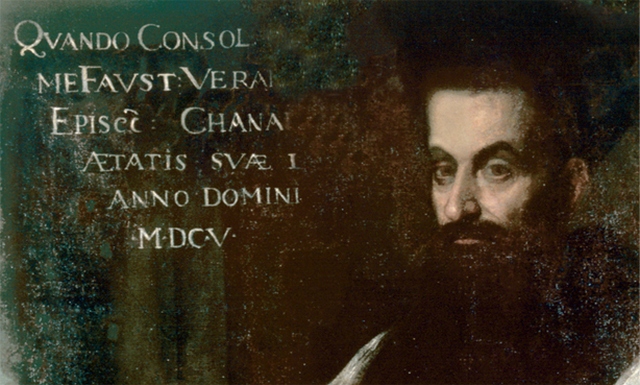
Faust Vrancic (1551-1617), distinguished Croatian inventor and
encyclopaedist, is burried upon his last wish,
on the island of Prvic near the city of Sibenik on Croatian coast.
He is best known for his book of inventions in Machinae Novae, published also in Venice in 1595. The book was financially supported by the French King Louis XIII, and the Toscan Duke Cosimo II de Medici. Among his numerous inventions the most famous is the parachute, which he tested in Venice. It is true that Leonardo da Vinci had a similar idea earlier, but he made only a rough sketch of it, of pyramidal shape, while Vranic's parachute had rectangular shape, as today.
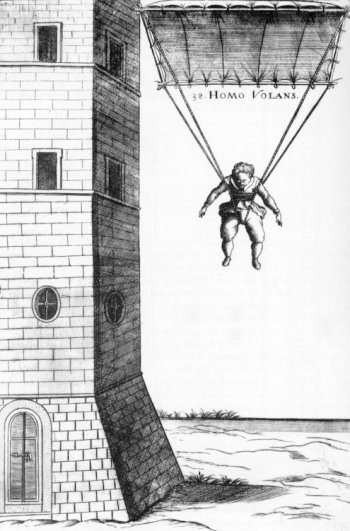

See Faust
Vrancic
(by dr. Vladimir Muljevic, in Croatian)
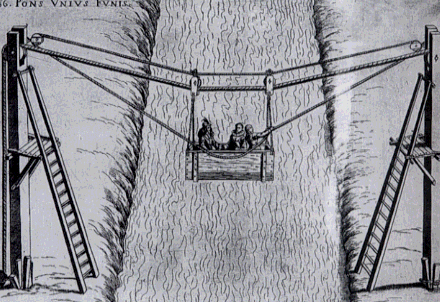
Vrancic also described in his book Machinae Novae the first wind turbine:

- in 1965 by "Heinz Moos Verlag", Munich, Germany (F. Klein, A. Wisner), translated into five languages,
- in 1968 by "Ferro", Milano, Italy (Umberto Forti), in Italian
- in 1985 by "Magveto", Budapest, Hungary, in Hungarian,
- in 1993 by "Novi
Liber", Zagreb, Croatia (Vladimir Muljevic,
Zarko Dadic), in Latin and Croatian
(from the introduction:
"...This book is issued in dramatic time for Sibenik and its environs, for Dalmatia, and the whole of Croatia [that is, issued during Greater Serbian 1991-1995 aggression on Croatia]. The aim and importance of this book should be close and clear to any civilized person: it radiates with Renaissance spirit of activism and optimism that we also wish to develop in our time, despite all misfortune brought to us by imposed war...")
For more information see
- Gojko Nikolić: Nove spoznaje o životu i izumima Fausta
Vrančića, Povijest i filozofija
tehnike, Zagreb 2017. Zvonko Benčić i Josip Moser (eds.), ISBN
978-953-7992-06-4, pp. 38-65.
- Vladimir Muljević: Hrvatski znanstvenici Faust i Antun Vrančić, Encyclopaedia Moderna, 2(42) (1993), pp. 122-136.
Faust Vrancic 1551-1617 Memorial Center on the island of Prvic near the town of Sibenik in Croatia
Nikola Sorgoevic, a sea captain from Dubrovnik (born on the island of Sipan), wrote several books on navigation, shipbuilding, and tides, and three of them have been preserved. Two of them have been published in 1574 in Venice, soon after his death in 1573.
Franjo Petris (Franciscus Patricius, a Croat born on the island of Cres, 1529-1597), a philosopher, mathematician and astronomer, was lecturing at the University of Ferrara and in Sapienza in Rome. During his stay on Cyprus (then belonging to Venice) he created a rich collection of Greek manuscripts, that finished in the Escorial. With his philosophical views of neoplatonism and sharp anti-aristotelism he influenced Giordano Bruno. His most important books are Nova de universis philosophia (New General Philosophy) and La citta felice (A Happy Town), published in Padova, treating the organization of ideal society, a forerunner of Campanella's "Civitas Solis" (1623). He is buried in the Torquato Tasso tomb in the church of St Onofrius in Rome.
Dominis, Mark Antun, (1560-1624)
Marin Getaldic - Marinus Ghetaldus (1568-1622) born in Dubrovnik, was the most outstanding Croatian scientist of his time. He studied in Italy, England and Belgium. His best results are mainly in physics, especially optics, and mathematics. Among his numerous books let us mention Promotus Archimedus (Rome, 1603) and De resolutione et compositione mathematica (Rome, 1630, in five voluminous books), in which Getaldic appears as a pioneer of algebraization of geometry.
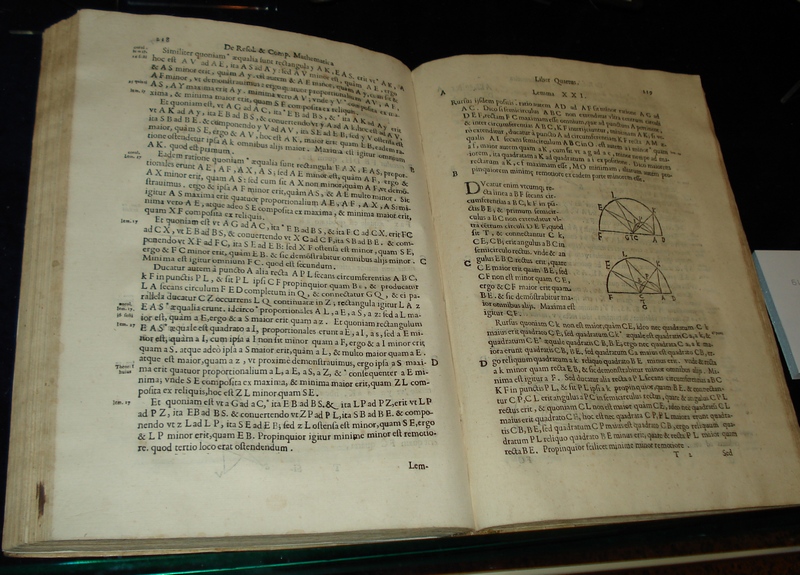
Marinus Ghetaldus: De
resolutione et
compositione mathematica, Rome,
1630.
A copy kept by the National and University Library in Zagreb.
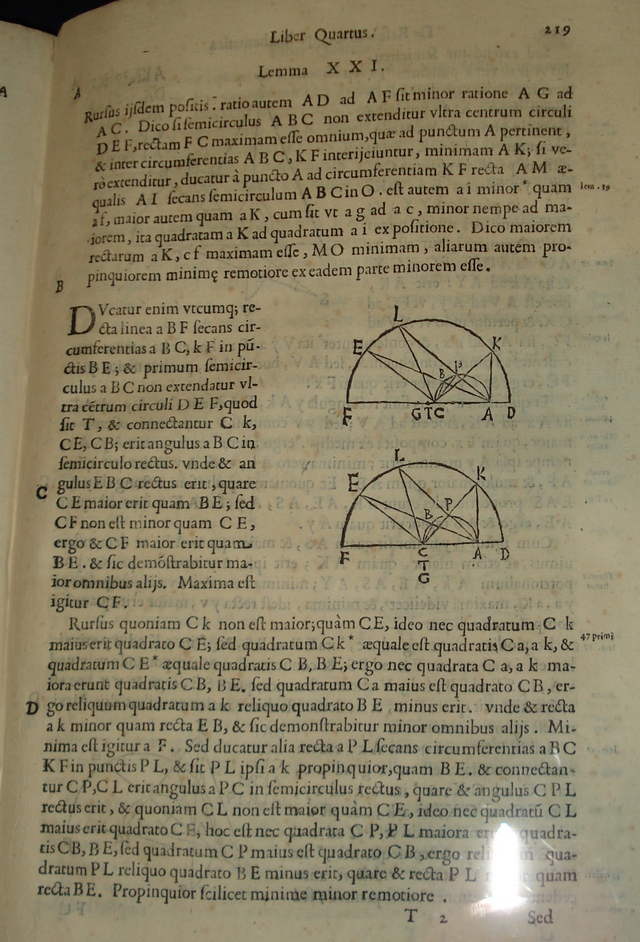
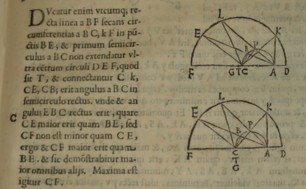
De resolutione et
compositione mathematica
libri qvinqvi (Rome, 1630, 343 pp., 22.5 x
31.8 cm),
published eight years after his death;
a detail from Lemma XXI;
Getaldic is considered to be the main predecessor of Analytic Geometry.
His contributions to geometry had been cited by Christian Huygens and Edmond Halley.

Marin
Getaldic, a portrait kept
in Rector's
Palace in Dubrovnik
Getaldic is the
constructor of the parabolic mirror (diameter 2/3 m), kept today in the
National Maritime Museum in London. During his sojourn in Padova he met
Galileo Galilei,
with whom he corresponded regularly. He was a good friend to the French
mathematician François
Viète. The fact that
the post of professor of mathematics had been offered to him in Louvain
in Belgium, at that time one of the most famous university centers in
Europe, proves his high scientific reputation.
A
Venetian Paolo Scarpi wrote about him: In
mathematics he was like a demon, and in his heart - like an angel.
- Marini Ghetaldi: Promotus Archimedus, Rome 1603 (online book provided by the Archimedus Project)
- Marin Getaldic (in Croatian)
 Ferdinand
Feller, the
eldest brother of Vilim
(William) Feller
(1906-1970), is the author of the graphic sign of the Croatian optical
industry Ghetaldus, named after Marinus Ghetaldus, that is,
after
Marin Getaldić. Photo by D.Ž. in
the city of Rijeka.
Ferdinand
Feller, the
eldest brother of Vilim
(William) Feller
(1906-1970), is the author of the graphic sign of the Croatian optical
industry Ghetaldus, named after Marinus Ghetaldus, that is,
after
Marin Getaldić. Photo by D.Ž. in
the city of Rijeka. See also Elsa fluid.
It seems that Dubrovnik was in possession of Archimedes' telescope, about which a testimony exists written in 1672 by Antun Sorgo (Sorkocevic, son of distinguished Dubrovnik composer Luka Sorkocevic), in his book "Origine et chute de l'ancienne Republique de Raguse". Antun Sorgo was the last ambassador of the Dubrovnik Republic to France, where he spent 35 years. The Archimedes' telescope seems to have been lost during the desastrous Dubrovnik earthquake in 1667. The basic idea of Archimedes' reflecting telescope (3rd ct. BC) seems to coincide with that of Newton's reflecting telescope (Isaac Newton, 1642–1727).
One of the most outstanding Dubrovnik mathematicians, physicists and astronomers of the 17th century was Stjepan Gradic (1613-1683), who was a Director of the Vatican Library. Some of his experimental results are cited by Jacob Bernoulli, and his tractate about navigation incited Gottfried Wilhem Leibniz to discuss the problem of steering ships using helms. Gradic's book Disserationes physisco-mathematicae quatour was published in Amsterdam in 1680. He died in Rome, where according to his last wish he was buried in the Croatian church of St. Jerome.
Ivo Puljizic, born in Pucisce on the island of Brac, made irrigation plans for the Vatican and projected various Vatican bell-towers in the time of Pope Innocent X, 17th century.
In 1673, a map of Croatia was published by the then Croatian
dignitaries, in which a unit of Milliaria
Croatica (i.e., Croatian mile
or hrvatska milja) appears,
defined as follows:



Lit.
-
Zemljovid Hrvatske iz god. 1673., izradio ga
Stjepan Glavač D. I., Sarajevo 1937. (here, D.I. = Družba Isusova = Society of Jesus)
- Croatian
Technical Lexicon.
Quite a number of Croats took part in the first Christian Missions, especially in South and North America and Asia. Ferdinand Konscak, or Fernardo Consag (born in Varazdin, 1703-1757), was a Jesuit and a Croatian missionary in North America. In 1752 he discovered that Baja California was not an island, as it had been believed until then, but a peninsula. There is a collection of rocky islets on the north of the Californian bay named in his honour as the Consag Rocks (Consag Rocas, or Roca de Consag, near San Felipe).
Denis Diderot and D'Alambert used some of his maps for the French Encyclopedia, see "Encyclopedie", Supplement 5 Carte (Paris 1755-1780), where his name is cited as P. Consaque. Alexander Humbolt used his maps for his "Carte generale... de la Nouvelle Espagne", Paris, 1804, and also Arrowsmith in his "Map of America", London 1805.
The map of Ferdinand Konscak, correctly representing California as a
peninsula for the first time.
CALIFORNIA per P. Ferdinandum Consak S.I. et alias /
CALIFORNIA according to Father Ferdinand Konscak, S.J. (Society of
Jesus), etc.
Konscak spoke various dialects of local Indians, in particular a very difficult dialect of Cochinin Indians. He described a sort of boomerang that Indians used for hunting rabbits. His diaries were printed already during his lifetime (published by Villa-Senor y Sanchez, Ortega-Balthasar and Venegas-Buriel), and after his death translated into many languages. The 1761 copy of Konscak's manuscript about California is held in The British Museum. His work Carta del P. Fernando Consag de la Compania de Jesus, Visistaro de las Misiones de Californias (43 pages) is kept in the British Museum in London, Library of Congress Harper in Washington, John Carter Library in Providence, Library of Pomona College in Pomona, Henry E. Huntington Library in San Marino.
His life is described by outstanding american historian Peter Masten Dunne in his monograph Black Robes in Lower California, Los Angeles, 1952. Seven copies of his maps are published by Ernest J. Burrus in his work La obra cartografica, Madrid, 1967. In his 2000 monograph Zoric proved that Konscak was the author of important work Addiciones a las noticias contemidas en la Description compnediosa de lo descuviert y conocido de la California. Since Konscak discovered many springs of pouring water, it is not surprising that even today there exist shops and warehouses in California bearing his name: "Licores Konsag", "Konsag Liquor Store and Mini Market", "Konsaqua" (agua purificada) etc. For many more details see [Zoric] and [Gabric].
In the city of Ensenada in Mexico (on the Pacific coast of
Baja California) there is a street called Boulevard Fernando Consag, named
after Ferdinand Konscak. An international conference dedicated to Fernando Consag
was organized in Ensenada in 2009.
In his Addiciones... Konscak described the following amusing event with an (illiterate) Indian who had to carry a written message and a loaf of bread from one missionary to another. The Indian ate the bread on his road, and gave only the message to the missionary, without knowing that the message said among others that he had to bring bread as well. Being asked about the bread, the Indian said that he knew nothing about it. When the missionary told him that he ate it, he retorted "Who told you that?". The missionary answered "The paper that you brought told me that!" The next time the Indian was again asked to carry two loafs of bread and another written message. On his road he was passing by a huge rock, where he left the message, went with his loafs round the corner (so that the paper could not "see" him), and ate them. To his utmost amazement, the paper told the missionary not only that he ate the bread, but also how many loafs he ate. The Indian, having admitted that he indeed ate the bread, nevertheless claimed that it was impossible that the paper could see him eating the bread: "...I hid the paper so that it could not see me...The paper is the chatterer that speaks about things it did not see". Taken from [Zoric, pp. 177-178].
Tomislav Gabrić: Ferdinand Konšćak, DI (1703-1759)
Misionar i istraživač, Verbum, Zagreb 1994.
Ignacije Szentmartony (1718-1793) was a Croatian Jesuit born in Croatian north (Kotoriba in Medjimurje), of a Croat mother and Hungarian father. After his studies in Vienna and Graz he lectured mathematics in Graz. In 1751 he went to Lisabon, where he obtained the title of royal mathematician and astronomer, and as such was designated to be a member of expedition for determining borders. In 1753 he sailed off from Portugal to the mouth of Amazon river for geographic research there. Only a small amount of his work is preserved to these days: two maps of the Amazon and Rio Negro. By the end of his life, upon return to Croatia, he wrote the first Croatian kajkavian grammar for Germans: Einleitung zur kroatischen Sprachlehre für Teutschen, Varazdin 1783. For more information see [Zoric].
Rugjer Boskovic (1711-1787), the greatest Croatian scientist in history

The oldest Croatian book on arithmetic is Arithmetika Horvatszka (literally Croatian Arithmetic) from 1758, published in Zagreb. It was written by Mijo Silobod Bolsic.
The first balloonist in Croatia was Karlo Mrazovic, who performed two balloon flights in Zagreb with his own balloons in 1789 and 1790. He was born in Boka kotorska. See [Croatia - Europe, III, Barok i prosvjetiteljstvo, p. 426, the article by Vladimir Muljevic].
Simun Stratik (Simone Stratico, 1733-1829), outstanding specialist in nautical theory, was born in Zadar (in the family of Schiavoni which came to Zadar from Crete). He lectured mathematics and nautical theory in Padova, and then nautical theory at the University of Pavia. By the end of his life he prepared a new edition of Vitruvius' famous Architecture (1825) in four books accompanied with 320 tables. He published among others
- his translation into Italian (published in Padova in 1776) and his commentaries to the book of a famous Swiss mathematician Leonhard Euler Theorie complette de la construction et de la manoeuvre des vaisseaux (1733); Euler's text has 360 pp, and Stratik's commentaries 180 pp; the translation into Italian appeared before English and Russian translations;
- three language nautical dictionary Vocabolario di marina in tre lingue (Milano, 1813), Italian-French-English (in three books, the first book has more than 500 pp); the fourth book was also planned, but never issued.
Ludwig
(Ljudevit) Mitterpacher von Mitterburg
(Mitterburg = Pazin in Istria, 1734 - 1814), was born in Bellye (Bilje
in eastern Croatia, near Danube river) and educated in Austria. He
studied mathematics and theology at Vienna University and was appointed
a teacher of religion in 1762. In 1777, Mitterpacher became the first
professor of the newly-established agricultural faculty at the Pest
University, a position he kept until his death. A very popular
lecturer, Mitterpacher also wrote several schoolbooks and lecture
notes. His most significant work was the three-volume Elementa
rei Rusticae,
a comprehensive study of agricultural
science and practice. Subjects included cultivation, plant-growing,
horticulture, vine-growing, forestry, animal husbandry and food
processing.
His books originally written in Latin language were translated into
several
languages and became important works of reference for contemporary
science.
Mitterpacher became a member of the Academy of Sciences in Bologna.
Many
thanks to Mr. Darko Varga (from Bilje, Baranja) for having
contributed Mittepacher's biography to this web.
Filip Vezdin or Wesdin (Paulinus a Sancto Bartolomaeo, 1748-1806), pioneer of European indology, was born in a Croatian village of Cimov (Hof am Leithagebirge) in Lower Austria in Burgenland (Gradisce). He completed his studies of philosophy and theology, Roman languages and English in Linz and Prague. Besides native Croatian he spoke Latin, Greek, Hebrew, German, Hungarian, Italian, Portuguese and English. As a Carmelitan missionary (with monastic name Paulin of St. Bartholomew) Vezdin was sent to India in 1776, where he learned Sanskrit and several Indian dialects.
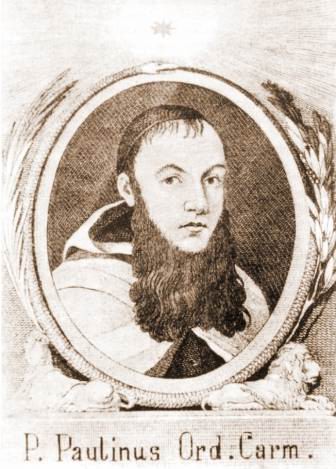
For
more information see Filip
Vezdin (in Croatian)
Vezdin is the author of Sidharubam seu gramatica samscrdamica, the first printed Sanskrit grammar in Europe, published in 1790 in Rome. Extended edition was published in 1804 and entitled Vyacarana seu locupletissima samsrdamicae linguae instituio.
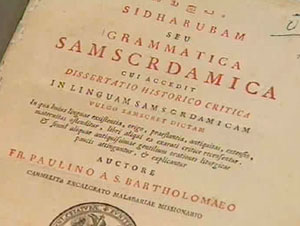
The
first printed Sanskrit
grammar in
Europe, written by Filip Vezdin in 1790,
photo from volksgruppen.orf.at/hrvati/visti/stories/45925/
He wrote numerous works on Indian culture, and in addition to Sanskrit also learned Malayalam, the Malabar coastal language, in which he wrote his works as well. At the request of a local ruler, King Rama Varmer of the Travancore, he wrote an English-Portugese-Malayalam grammar. The King, enthusiasted with Vezdin's fluency in Malayalam, asked him to be his teacher of English and Portuguese in his palace in Padmanabpuram. Vezdin's works are kept in Rome, Vienna and Uppsala. The first methodical study of connections between Indo-European languages is contained in his work De antiquitae et affimitate lingaue zendicae, samscrdamicae et germanicae disseratio, Rome 1798.
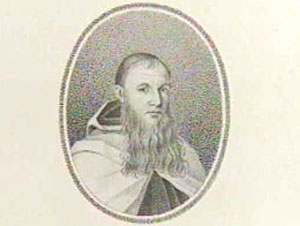
Filip
Vezdin, pioneer of
European indology,
photo from volksgruppen.orf.at/hrvati/visti/stories/45925/
Vezdin's best known work is Systema brahmanicum liturgicum, mythologicum, civile ex monumentis Indicis Musei Borgian Velitris, Rome 1791, dealing with literature, mythology and civil order of brahmanic India, customs and the way of life. His most interesting and most popular work is his travel-book Viaggio alle Indie orientali, Rome 1796. He also published two philological studies about connections between Hungarian and Laponian languages. Vezdin is considered as one of pioneers of European indology.

About twenty of his books were published already during his lifetime. Some of them were translated into German, French, English and Swedish. It is therefore no surprise that he was a member of the Royal Academy in Naples, and of the Academy "Dei Volsci" in Velletri and Padova.
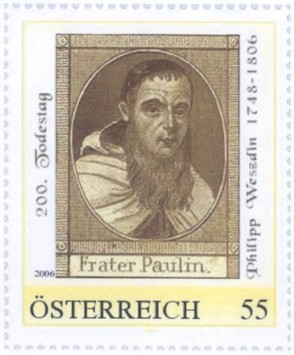
A
postage stamp issued by a Cultural Association, Hof
am Leithaberge, Austria in 2006, commemorating 200 years since Vezdin's
death.
Many thanks to Dr Luca Leoni, Velletri.
In 2006 a memorial tablet dedicated to Filip Fezdin was placed in Velletri, a town near Rome, on the building of Museo Borgia (in Via della Trinita), where Vezdin had been working. The tablet mentions his Croatian descent: "Croato del Burgenland". Also, on that occasion an Italian translation of the monograph written by Dr. Branko Franolic about Filip Vezdin was promoted in the City Council of Velletri ("Paolino di San Bartolomeo, pioniere dell'indologia nell'Europa di fine Settecento", translated from the English original by Dr. Luca Leoni).
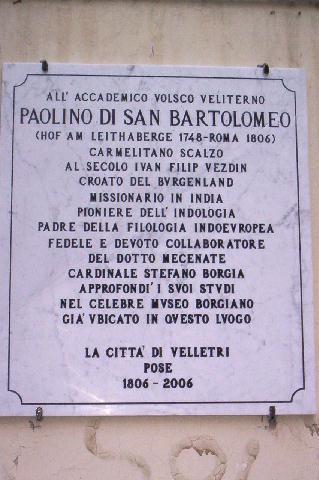
Memorial
tablet dedicated to
Filip Vezdin
in Velletri, Italy, 2006
Many thanks to Dr Luca Leoni, Velletri, for the photo and his
translation:
|
TO VELLETRI'S VOLSCIAN
ACADEMIC THE CITY OF VELLETRI |
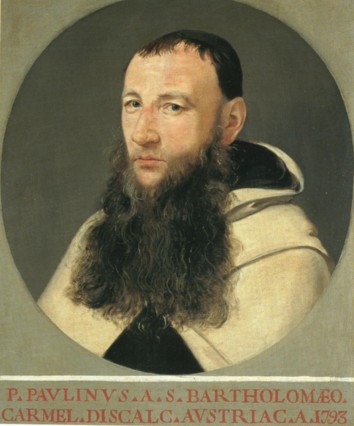
Filip
Vezdin, portrait from
1793 probably
by J.H. Cabott (1754-1841),
once in cardinal Stefano Borgia's library in "Palazzo Altemps", Rome,
now conserved in "Propaganda Fide", Rome
(many thanks to Dr Luca Leoni, Velletri)
Vezdin's research gave a great impetus to investigation of culture and civilization of India in Europe. In 1999 Vezdin's image was carved into the white marble memorial plaque in the City Museum of Trivandrum, the capital of the Indian state of Kerala. Furthermore, the following text was written in the Sanskrit, Malayalam, Croatian and English languages on memorial tablet in the museum:
| Ivan Filip Vezdin, Burgenland Croat, Discalceate Carmelite, with the monastic name Paulin of St. Bartholomew, a missionary in Malabar from 1776 to 1789. The author of the first printed Sanskrit grammar and forerunner of Indian and Indo-European studies to the great honour of his homeland and the Croatian and Indian people. |
| Ivan Filip Vezdin, gradiscanski Hrvat, bosonogi karmelicanin, 1776. - 1789., misionarski je djelovao na Malabaru. Pisac prve tiskane sanskrtske gramatike i preteca indijskih i indoeuropskih studija na veliku cast svojoj domovini te hrvatskom i indijskom narodu. |
According to distinguished Croatian linguist Vatroslav
Jagic
(1838-1928), Filip Vezdin was born in lower-Austrian village of Hof an
der Leitha, and in this village already in the time of Jagic [more
specifically, in1865, when Jagic wrote these lines] only the Croatians
live, and speak between themselves Croatian, while the older people do
not speak German. According to Jagic, it can be said for sure that
Vezdin's mother did not speak German, while his father understood
hardly anything of German. Jagic mentioned a realiable friend of him,
who said that Vezdin's relatives still live in that village, and that
they are true Croatians. Source Vatroslav Jagic: Slovjensko
jezikoslovlje, Zagreb 1865. Here is Jagic's original text in Croatian:
... Doskora zatim sazna Evropa i pobliže o sanskritskom jeziku. Ime onoga, koji napisa prvu sanskritsku gramatiku kao izučen tudjinac, dvostruke je po nas ovdje važnosti: ne samo što je to bila prva od Evropejca i za Evropejce sastavljena gramatika toga jezika, nego takodjer što ju je napisao naš čovjek, Hrvat rodom iz Austrije, po imenu Ivan Filip Vezdin, učenomu svietu poznatiji pod redovničkim imenom Paulinus a Bartholomaeo. On dakle napisa prvu gramatiku sanskritsku, te je izda na sviet u Rimu god. 1790; osim toga ima od njega i drugih znamenitih knjiga, koje se tiču sanskritskoga jezika, književnosti i starina. Da je Vezdin zbilja pravi Hrvat bio, rodjen u dolnjo-austrijskom selu Hof an der Leitha, to je podpuna istina; zato što u onom selu još i danas (1865.) živu sami Hrvati, te i danas medju sobom samo hrvatski govore, a stariji ljudi niti ne umiju njemački. Može se dakle za cielo reći, da Vezdinova majka nije nimalo, a otac jedva štogod razumio njemački. Osim toga kaza mi vjerodostojni prijatelj (Pavao Žulić, moj dodatak), da i njegova rodbina još u onom selu živi, pak i oni su sami korjeniti Hrvati. To sam ovdje zato napomenuo, da se svakomu pravo učini; dakle i nam da bude, što je naše. (See Hrvatske novine, Tajednik Gradišćanskih Hrvatov, 6. 4. 2012, or the journal Književnik, Zagreb, 1865, no 2, pp. 507-509, where the original Jagic's text appears.)
For more information see
- Branko Franolic: Filip Vezdin ("Filip Vezdin’s contribution to indic studies in Europe at the turn of the 18th century")
- [Zoric]
- Filip (Philippus) Vezdin (Vesdin), 1748.-1806.
- Luca Leoni: Nel bicentenario della morte del carmelitano scalzo di origini croate che fu pioniere dell’indologia e padre della filologia indoeuropea
- Tomislav Mrkonjic: "Velikan hrvatskih korijena", Glas Koncila, 19 February 2006, p. 18
- Zdravka Matisic: Radost, strah, predanost / Joy, Fear, Dedication; Contribution to the biography of Filip Vesdin Paullinus a Sancto Bartholomaeo, in Croatian and English, Odjel za orijentalistiku Hrvatskog filoloskog drustva i Filozofski fakultet, Zagreb 2006
Franjo Domin (born in Zagreb, 1754-1819), studied physics and theology in Vienna and later became a dean at the Faculty of Philosophy and rector of the University of Budapest. He was among the first who cured various diseases by electrotherapy using static electricity.

Nikola Toma Host (Nikolaus Thomas Host, or Nicolai
Thomae Host, 1761-1843) was a personal physician of the Austrian
Emperor Franz I. The Botanical Garden of the University of Vienna bears
his name: Host's Garden (Host’scher Garten), which he has directed
until his death in 1834. His herbarium is kept in the Nature Museum in
Vienna.
The first torpedo was constructed by Ivan Lupis Vukic in the 19th century in Rijeka, where its production had started in 1866 in the Whitehead factory. He was born in the village of Nakovane on the beautiful Peljesac peninsula near Dubrovnik.
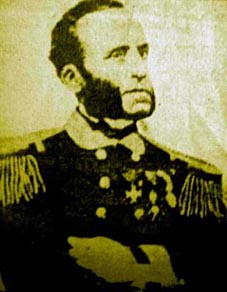


The project for the Theater building in Rijeka was drawn up by Helmer and Fellner studio from Vienna. The building was illuminated with electricity, one of the first theaters in the world to have its own generator. See the reference below, p. 156:
Miljenko Smokvina: Rijeka na povijesnim fotografijama, 2nd ed, Ruševic & Kršovik, Rijeka 2003.Around the middle of the 19th centurz, a metal factory was built in Rijeka. It was later reconstructed into a shipzard, where the first Croatian metal steamship Hrvat (i.e. Croat) wa built in 1872 for the city of Senj. Following Following he ideao of Ivan Lupis from Rijeka, the first torpedo was constructed there. See [Smokvina p. 191].
The first ship-screw (propeller) has been constructed by Yosip Ressel in 1827 (the first steamers were constructed with paddles). Joseph Ressel was of the Czech and German origin, working as engineer of forestry in the lovely Istrian town of Motovun. It is interesting that this important discovery was inspired by ordinary spiral corkscrew. The first propellers were tested on a boat in Trieste. The first journey across the Atlantic with screw-driven ship was in 1839 within 40 days, with Ressel's screw improved by Swedish engineer John Ericsson.
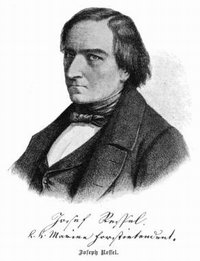
![]()

It has led to contemporary ship-screw:
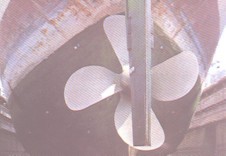
In
1888 Josip Belusic
constructed the first electric
speedometer.
Belusic was born in the region of Labin in
Istria, and was professor in Kopar. This invention was patented
in Austria - Hungary under the name of "velocimeter."
NOTE: Nikola
Tesla (1856-1943) is since
recently
credited for this discovery, see
here.
David Schwarz, a Zagreb Jew (1852-1897), invented steerable metal airship that is today unjustly bearing the name of the German count Zeppelin. Indeed, Zeppelin bought the complete project from Schwartz's wife, shortly after his premature death. It is true that in 1897 the `Zeppelin' constructed by Schwartz fell down during its trial flight near Berlin, due to a small technical error in the propeller, having reached the height of 460 m. It was 47.5 m long and had 35 tons.
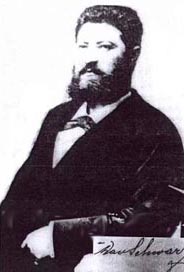

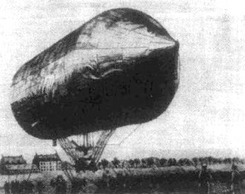
The American Israel Numismatic Association issued two nice plaquettes in honour of David Schwarz, see here.
The Croatian Jews left truly remarkable traces in arts, music, science and architecture.

Ante Šupuk (1838-1904) second from the left. The machinery for the
Šibenik AC electric power system,
operating since 1895, was produced by the GANZ co. in Budapest.
It is not widely known that one of the earliest AC (alternating current) electric power systems in the world has been built up in Croatia, on the beautiful Krka waterfalls (one of Croatian national parks). It brought light to the city of Sibenik, 11 km from the power plant. It was built in 1895, one year before Nikola Tesla's famous power plant on the Niagara falls. The chief engineer was Ante Supuk. The plant brought light to the Šibenik cathedral, which was the first cathedral in the world lighted with AC.
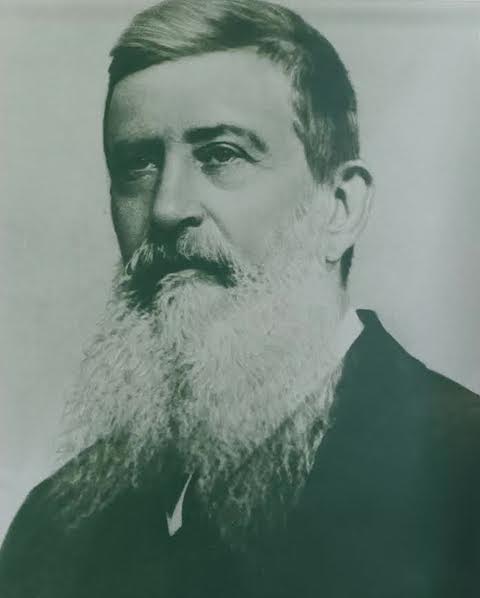
Ante Šupuk, Croatian inventor, entreprepenur, and
politician, mayor of the city of Šibenik, Croatia.
Modern Slavic studies were founded by Vatroslav Jagic (born in Varazdin, 1838-1923), professor of philology at the Universities of Zagreb, Berlin, Vienna, Sankt Petersburg, Odessa. He was a full member of the Petersburg's and Austrian Academies of Sciences. A great importance for the development of Slavic philology had the journal Archiv fur slavishe Philologie that he founded in Berlin, and whose editor in chief he was during 45 years. He also initiated and organized the Seminar for Slavic studies in Vienna in 1887, which later grew out to the Institute of Slavic Studies. His scientific opus is enormous: if collected, it would occupy about 100 books.
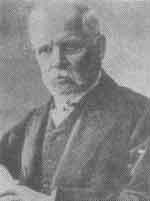
Among numerous scientific
collaborations, we mention a distinguished French scientist Louis Leger (a pioneer in
Slavic studies), who wrote a
nice dedication on a separate page of his book La mythologie slave, published in
Paris in 1901: "A mon vieil ami et confrère V. Jagic ce livre est
cordialement dédié". Louis
Leger is known for his study of the famous Reims Evangel, kept in the Municipal Library in
Reims, France, the second part of which was written in Croatian Glagolitic Script in
Prague in 1395.
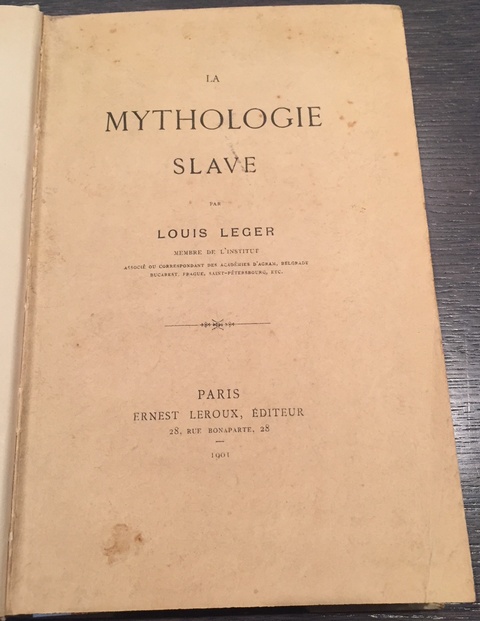
Many thanks to dr. Antonija Zaradija Kiš, Zagreb,
for showing me her copy of this book.

Some important discoveries in the field of Croatian archeology were accomplished by don Frano Bulic (1846-1936). Especially important was a discovery of an inscription on the sarcophagus of queen Jelena (10th century).
One of the pioneers of telegraphy is Ferdinand Kovacevic (1838-1913). He invented the possibility of telegraphic connection along a single wire (the duplex connection), whereas before four wires had been used. By the way, Zagreb had its telegraph lines only six years after the first telegraph lines in the world introduced by Morse (Washington-Baltimore, 1844).
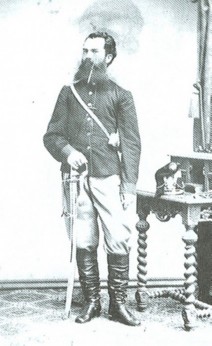
Ferdinand Kovačević
Telegraph connection with the Croatian region of Lika, where Kovacevic was born, had been established already in 1854. Kovacevic published several electrotechnical books in Zagreb in German language. It is interesting that Ferdinand Kovacevic was born in the village of Smiljan in Lika, i.e., in the same village as Nikola Tesla.
A zoologist of international reputation Spiridion Brusina (born in Dubrovnik, 1845-1908), analyzed and classified 600 fossil species. He has a great merit for popularizing science in Croatia. Natural scientists throughout Europe named in his honor about 50 species according to his name.
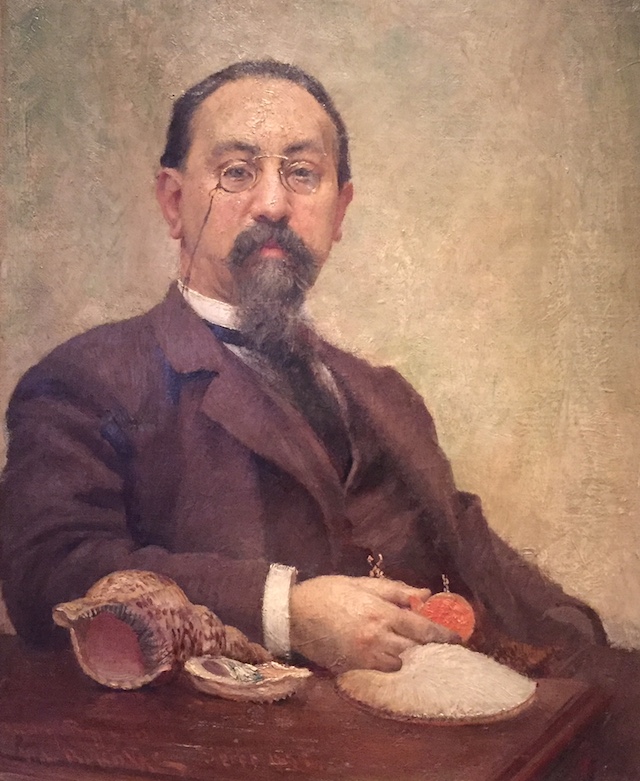
Portrait of Špiro Brusina, 1895,
by Vlaho Bukovac, distinguished Croatian painter.
Croatian Natural History Museum, Zagreb
Vinko Dvořák (1848-1922), Czech who came from Prague to Zagreb in 1875 and was lecturing physics at the University of Zagreb, was the student of Ernst Mach. He is well known by his discoveries in acoustics, especially about acoustic forces. He was the first constructor of an acoustic radiometer, which has been unjustly attributed to Rayleigh. Information by professor Vatroslav Lopasic, professor of physics at the University of Zagreb.
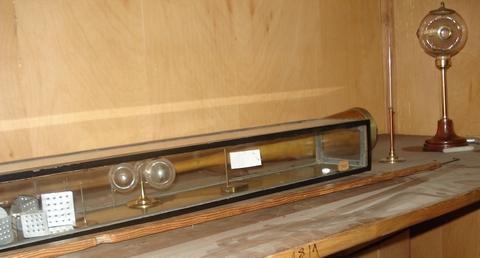
Parts
of acoustic radiometer
constructed by Vinko Dvořák, kept in the Department of
Applied
Physics
of the
Faculty of Electrical Engineering and Computing, University of Zagreb.
The aim of the instrument is to study mechanical effects
of sound.
Gustav Janeček
(1848-1929), pharmaceutist and chemist born and educated in Czechia,
since 1879 was employed at the University of Zagreb. In the period of
1908-1909 he was a rector of the University of Zagreb. He was important
in organizing the study of chemistry at the University of Zagreb. Under
his mentorship, the first PhD in Chemistry in Croatian was defended in
1886. In 1893 he founded the Association for the
Conservation and Enhancement of the Plitvice Lakes.
He was a member of JAZU (since 1991 HAZU - Croatian Academy of Sciences
and Arts) in Zagreb since 1887, president of its Department of
Mathematics and Natural Sciences in the period of 1908–17, and
president of the Academy in
the period of
1921–24. He was an extraordinary member of the Czech Academy of
Sciences.
Peter Salcher (1848 – 1928), professor at the Rijeka Naval Academy, was a close associate of Ernst Mach and succeeded in what the famous physicist could not achieve - to make a picture of the invisible. Mach wanted to provide experimental evidence of his hypothesis about the existence of a shock wave around objects moving at speeds greater than the speed of sound. Therefore, he asked Salcher to try gaining such evidence in his laboratory in Rijeka. No sooner said than done.
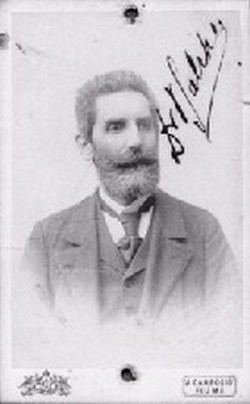
Peter
Salcher, author of the first ultra-fast photo of a shock wave
around flying gun bullet
In 1886, Salcher and his associate Sandoro Riegler took a series of ultra-fast photographs of the acoustic phenomena that arise around a flying gun bullet, thus proving the existence of the shock wave, today also known as the sound barrier.
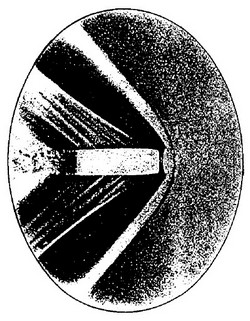
The
Salcher photo of the shock wave around flying gun bullet. Source.
His work was a scientific sensation. Could the unit for the speed of sound, instead of Mach, have been Salcher? We'll leave that question unanswered and just remember that Salcher during his experiment actually took the first ever photographs of – a flying bullet. Source of the text www.kvarner.hr .
One of the students of Peter Salcher was Ludwig von Trapp.
Croatian science, 20th-21st centuries
Croatian medicine
Croatia - an overview of its History, Culture and Science
